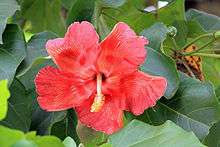Thespesia grandiflora
Thespesia grandiflora is a tree in the family Malvaceae of the rosids clade.[2] Its common name is maga.[2] This tree is widely distributed throughout Puerto Rico where it is endemic.[3][4] Although originally endemic to the humid mountains of limestone in the western and north-central portions of the Island, today it grows everywhere in Puerto Rico due to its extensive cultivation.[5] It is also grown as an ornamental tree in Florida, Hawaii, Honduras and in various Caribbean islands.[5] The maga is mostly used as an ornamental plant, but like the related Thespesia populnea its wood is also valued for its durable timber.[5] The flower was declared the national symbol of Puerto Rico on August 7 2019.[6]
| Maga | |
|---|---|
 | |
| Scientific classification | |
| Kingdom: | Plantae |
| Clade: | Tracheophytes |
| Clade: | Angiosperms |
| Clade: | Eudicots |
| Clade: | Rosids |
| Order: | Malvales |
| Family: | Malvaceae |
| Genus: | Thespesia |
| Species: | T. grandiflora |
| Binomial name | |
| Thespesia grandiflora | |
| Synonyms[2] | |
| |
Flower
The flower of the tree, known as flor de maga, is the official national flower of Puerto Rico. It is sometimes called a hibiscus in English, although it belongs to a different genus, and species from the true hibiscus and is more closely related to Cotton.
Growth
The maga tree usually grows no larger than 20 meters.[5] It is grown for timber and as an ornamental plant.
References
- "Thespesia grandiflora". Germplasm Resources Information Network (GRIN). Agricultural Research Service (ARS), United States Department of Agriculture (USDA). Retrieved 31 March 2009.
- Thespesia grandiflora DC. ITIS Standard Reports. Taxonomic Serial No.: 21764. Integrated Taxonomic Information System. 5 September 2013.
- Thespesia grandiflora DC. (maga). USDA. Natural Resources Conservation Service. Retrieved 5 September 2013.
- La Reforestacion Gubernamental en Puerto Rico.] Frank H. Wadsworth. Instituto Internacional de Dasonomía Tropical. U.S. Forest Service. Río Piedras, Puerto Rico. {Acta Científica 22(1-3), 105-113, 2008.} Page 105. Retrieved 9 September 2013.
- Thespesia grandiflora (DC.) Urban. John K. Francis. USDA. Forest Service. Retrieved 5 September 2013.
- Entre leyes y múltiples indultos. Cesiach López Maldonado. Primera Hora. 11 August 2019. Accessed 12 August 2019.
Bibliography
- Bailey, L.H. 1941. The standard cyclopedia of horticulture. New York: Macmillan. 3,639 p.
- Calvesbert, Robert, Jr. 1970. Climate of Puerto Rico and U.S. Virgin Islands. Climatology of the United States 60-52. Silver Spring, MD: U.S. Department of Commerce, Environmental Science Service Administration, Environmental Data Service. 29 p.
- Holdridge, L.R. 1942. Trees of Puerto Rico. Occasional Paper 1. Río Piedras, PR: U.S. Department of Agriculture, Forest Service, Tropical Forest Experiment Station. 105 p. Vol. 1.
- Holdridge, L.R. 1967. Life zone ecology. San José, Costa Rica: Tropical Science Center. 206 p.
- Joland, S.D.; Wiedhopt, R.M.; Cole, J.R. 1975. Tumor inhibitory agent from Montezuma speciosissima (Malvaceae). Journal of Pharmaceutical Sciences. 64(11): 1889-1890.
- Liogier, Henri A.; Martorell, Luis F. 1982. Flora of Puerto Rico and adjacent islands: a systematic synopsis. Río Piedras, PR: Editorial de la Universidad de Puerto Rico. 342 p.
- Little, Elbert L., Jr.; Wadsworth, Frank H. 1964. Common trees of Puerto Rico and the Virgin Islands. Agric. Handb. 249. Washington, DC: U.S. Department of Agriculture. 548 p.
- Marrero, José. 1942. A seed storage study of maga. Caribbean Forester. 3(4): 173-184.
- Marrero, José. 1947. A survey of the forest plantations in the Caribbean National Forest. Ann Arbor, MI: University of Michigan. 167 p. Tesis de M.S.
- Marrero, José. 1948. Forest planting in the Caribbean National Forest: past experience as a guide for the future. Caribbean Forester. 1: 85-213.
- Martorell, Luis F. 1975. Annotated food plant catalog of the insects of Puerto Rico. Río Piedras, PR: Agricultural Experiment Station. 303 p.
- Neal, Marie C. 1965. In gardens of Hawaii. Special Publication 50. Honolulú: Bernice P. Bishop Press. 924 p.
- Sapath, D.S.; Balaram, P. 1986. Resolution of racemic gossypol and interaction of individual enantiomers with serum albumins and model peptides. Biochimica et Biophysica Acta. 882(2): 183-186.
- Schubert, Thomas H. 1979. Trees for urban use in Puerto Rico and the Virgin Islands. Gen. Tech. Rep. SO-27. New Orleans, LA: U.S. Department of Agriculture, Forest Service, Southern Forest Experiment Station. 91 p.
- Weaver, Peter L. 1987. Tree growth in several tropical forests of Puerto Rico. Res. Pap. SO-152. New Orleans, LA: U.S. Department of Agriculture, Forest Service, Southern Forest Experiment Station. 15 p.
- Wolcott, George N. 1939. The entomologist looks at maga. Caribbean Forester. 1(1): 29-30.
- Wolcott, George N. 1940. A list of woods arranged according to their resistance to the attack of the “polilla”, the dry-wood termite of the West Indies. Caribbean Forester. 1(4): 1-10.
External links
| Wikispecies has information related to Thespesia grandiflora |
| Wikimedia Commons has media related to Thespesia grandiflora. |